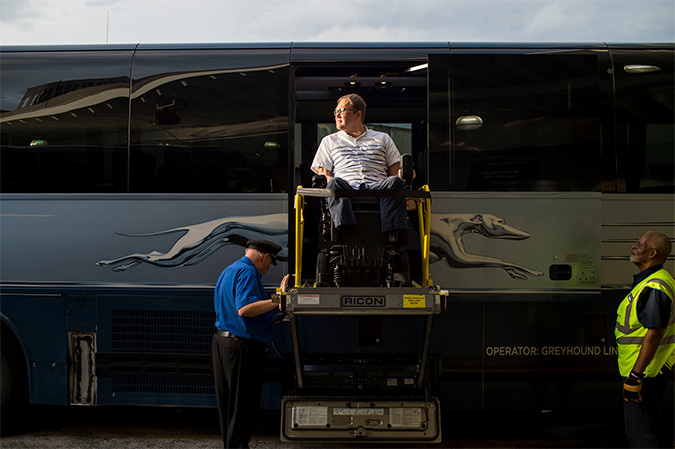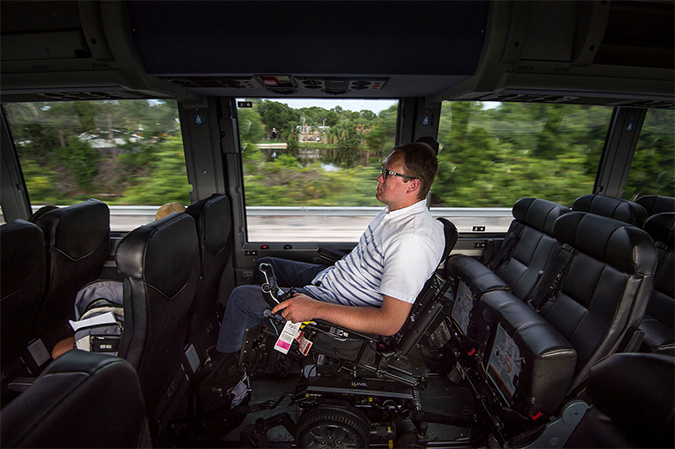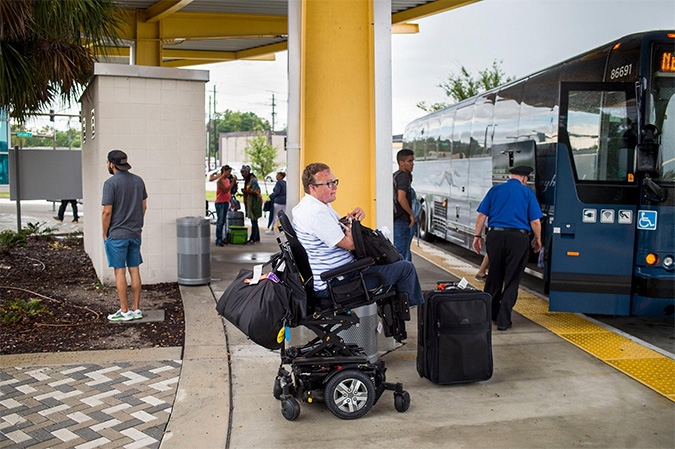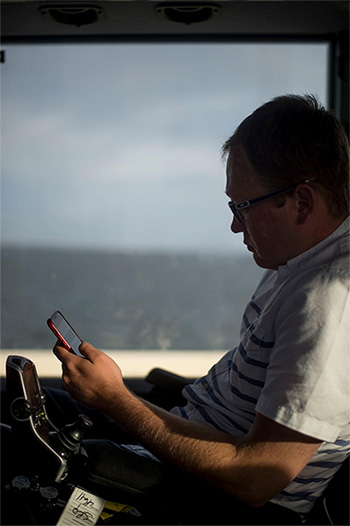
John Morris, a frequent traveler, getting off a Greyhound bus using the wheelchair lift after arriving in Tampa, Fla. Zack Wittman for The New York Times.
June 25, 2018
By JOSHUA BROCKMAN
Technology is fast changing how people with disabilities get to and then navigate airports and train and bus stations. But technology can go only so far: Its advantages usually stop at the door of the plane, train or bus.
Consider the experience of Michael May, who is blind and typically flies at least once a week. Mr. May, the executive director of Envision’s BVI Workforce Innovation Center, which provides employment training for the blind and visually impaired in Wichita, Kan., says he uses airline apps at home to secure his boarding pass, takes Uber to the airport and gets dropped off as close as possible to the Transportation Security Administration’s PreCheck. (He’s also enrolled in the Clear program to speed his way through airport security.)
But then he hits what he calls a void — he has to ask someone how to get to the security line. And in frenzied airports, he doesn’t always get a response.
“I’m looking forward to having indoor navigation to the point where I can at least get to PreCheck,” he said.
Mr. May has a cane and Jonnie, his golden retriever guide dog. He also draws on screen-reader software and smartphone apps. He uses the free app Be My Eyes, which relies on a network of 1.2 million volunteers to provide directions through the airport via live video. In addition, he uses Aira, a monthly subscription app that uses a smartphone camera or a pair of glasses outfitted with a camera to live-stream video to an agent, who then provides navigational instructions. Ten airports, including ones in Seattle, Boston, Houston, Memphis and Minneapolis, currently offer zones where blind and visually impaired travelers can download the Aira app and use the service without charge. (Several more airports are expected to offer complimentary service this summer.)
David Wilson, the director of innovation at the Sea-Tac Airport, says blind travelers no longer have to rely on wheelchair attendants. “With Aira, they can get up and go to a restroom, go to a concession,” he said. “It’s independence.”

Since 2014, Mr. Morris has taken more than 70 trips on Greyhound and Megabus combined. The lack of uniform setup for wheelchair boarding causes delays, he said. Zack Wittman for The New York Times.
Still, the Americans With Disabilities Act, which became law in 1990, applies to airports and ground transportation — trains, buses and subways. But airline cabins are governed by the Air Carrier Access Act, which was enacted in 1986 and does not carry as many accessibility requirements. If, for example, someone uses a motorized wheelchair, it must be checked at the end of the jetway. Wheelchair assistants, often contractors, help the passenger transfer to a wheelchair that can fit down the narrow aisles and then to their seat (a foldable aisle wheelchair is also kept on board).
“The most accessible feature on an airplane is the fact that the arm rest lifts up to get in and out of the seat, and that’s about it,” said Lee Page, a quadriplegic who uses a wheelchair full time and serves as the senior advocacy director for Paralyzed Veterans of America.
A spokesman for Delta Air Lines, Anthony Black, said its gate agents must complete a “comprehensive accessibility curriculum” for travelers with disabilities that includes training on everything from handling service animals to transfer assistance onto a plane. A spokesman for United Airlines, Charles Hobart, said the carrier had a 24-hour accessibility desk and also trained all of the employees who work directly with customers on how to assist passengers with disabilities. Southwest Airlines said all of its customer representatives were trained to help customers with disabilities, and it maintained a video relay and a Teletypewriter number for deaf travelers.
But disabled travelers, including Teresa Blankmeyer Burke, an associate professor of philosophy at Gallaudet University, who is deaf, say airlines could improve their training. She said she would like airlines to do a better job of reassuring deaf and hard-of-hearing travelers that “our presence has been noted and that we will not be overlooked.”
Sheryl Stroup, a safety expert for the Association of Flight Attendants-CWA, said flight attendants were responsible for communicating directly with disabled passengers to make sure their needs are met. “You need to go ask them, ‘How can I best assist you?’” she said.
Ms. Blankmeyer Burke says she wears a brightly colored piece of clothing or a distinctive hat so that she’s readily identifiable and introduces herself to the ticketing crew at the airport, train station or bus terminal with a note.
“I print out a script that tells the flight attendants a little bit about my communication needs and abilities, where I am sitting, and also notes my beverage preferences and my destination,” she said in an email. “In this document, I explicitly state that I want important announcements written and I ask who will be responsible for communicating with me in case of emergency.”

Mr. Morris at the Greyhound station in Sarasota, Fla. “Oftentimes, I find myself being the one to educate the driver on how to operate the particular lift that’s set up on their bus,” he said. Zack Wittman for The New York Times.
Ms. Blankmeyer Burke says she carries a small notebook or types inquiries on her smartphone and travels with a flashlight for lip reading.
Not everyone has a smartphone, and some people say they prefer the simplicity of human interaction even if they are tech savvy.
Bill McCann, the founder and president of Dancing Dots, a company in Phoenixville, Pa., that creates software to help blind and visually impaired musicians read, write and record music, said he navigated through the airport or an Amtrak station using the sighted-guide technique. He takes the arm of either the wheelchair attendant, a fixture at airports nationwide, or a member of Amtrak’s Red Cap team. At airports, he follows the attendant through T.S.A. PreCheck to his gate, keeping his cane out so people can identify him as a blind person.
“It’s a convenience,” he said. “It’s a timesaver. It reduces some of the stress of being in airports.” He said he viewed airports as “just below hospitals in terms of stress level.” At the gate, Mr. McCann said, he typically preboards — an option airlines must extend to anyone with a disability.
An accessibility consultant, John Morris, a triple amputee based in Orlando, Fla., uses a motorized wheelchair. He writes a wheelchair travel blog to share tips about air, bus and train travel. Since 2014, he said, he has taken more than 600 flights and over 70 trips combined on Greyhound or Megabus.
On Greyhound, an electronic lift carries the wheelchair user to a seating area that can accommodate two wheelchairs. But Mr. Morris said there was no uniform setup, and this caused delays. “Oftentimes,” he said, “I find myself being the one to educate the driver on how to operate the particular lift that’s set up on their bus.”
Delays can also make for an uncomfortable ride. When fellow passengers groan, Mr. Morris said, he feels like a “target sitting in the middle of the bus, and I have nowhere to go.”

Mr. Morris checks his phone on the trip to Tampa, Fla. An accessibility consultant, he writes a blog on wheelchair travel. Zack Wittman for The New York Times.
The National Federation of the Blind last year filed a lawsuit against Greyhound saying that neither the bus operator’s website nor its app was accessible for the blind, putting it in violation of both the A.D.A. and state laws. The case is in mediation.
“We are making our website and app more accessible to customers who use screen-reader software,” said Lanesha Gipson, a spokeswoman for Greyhound. Although the company requires its drivers to demonstrate their ability to operate wheelchair lifts, she said the lifts are “very fickle” and sometimes fail.
On Megabus, which operates two-level buses and is owned by Coach USA, wheelchairs roll on and off the first level via a portable ramp. Mr. Morris said he preferred this low-floor access because it “eliminates a break point.”
Still, he said, the grade of the ramps at some stations, including in Orlando, is too steep to be compliant with the disabilities act. He said he also worried about the safety straps. “I don’t think I’ve ever ridden the Megabus and felt as though the straps that lock my wheelchair down are secure,” he said.
Sean Hughes, a spokesman for Megabus, said that the ramp and wheelchair straps were designed “to meet all A.D.A. requirements” and that drivers take a mandatory training class to practice loading, tying down and unloading wheelchairs.
One advantage that both trains and buses offer over airplanes, Mr. Morris said, is the direct connection from city center to city center. Trains, he said, also provide one of the most accessible ways to travel. Amtrak lays down a ramp on train platforms to bridge the gap at the station for wheelchairs. There’s also a mechanical lift to hoist a wheelchair user into or out of the train if it is not level with the platform. On Northeast corridor trains, there is space at the end of each car to accommodate wheelchair users. Over all, Mr. Morris said, he preferred the dedicated wheelchair space and the accessible bathrooms on Amtrak’s Acela service.
Airplanes are another story. Twin-aisle planes, typically used for international flights, are required to have an accessible lavatory. But single-aisle airplanes, a staple of domestic routes, rarely have one. Delta says it will have the Bombardier CS100, its first narrow-body aircraft outfitted with an accessible lavatory, in service next January.
Read original article, which appeared on Page B5.
© The New York Times Company
